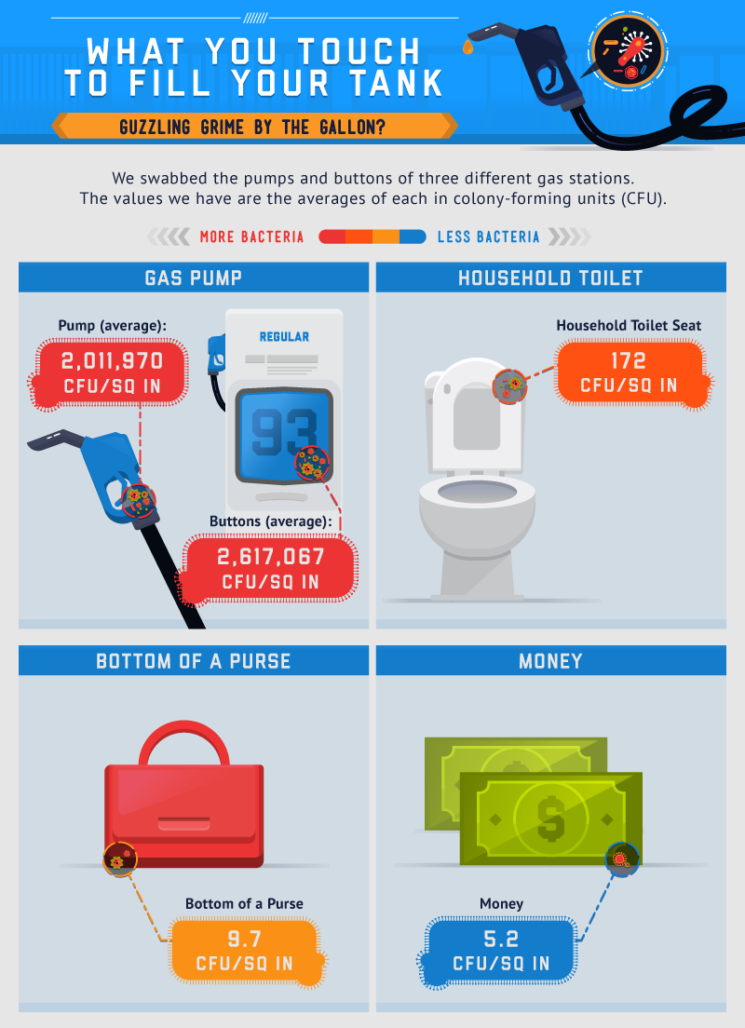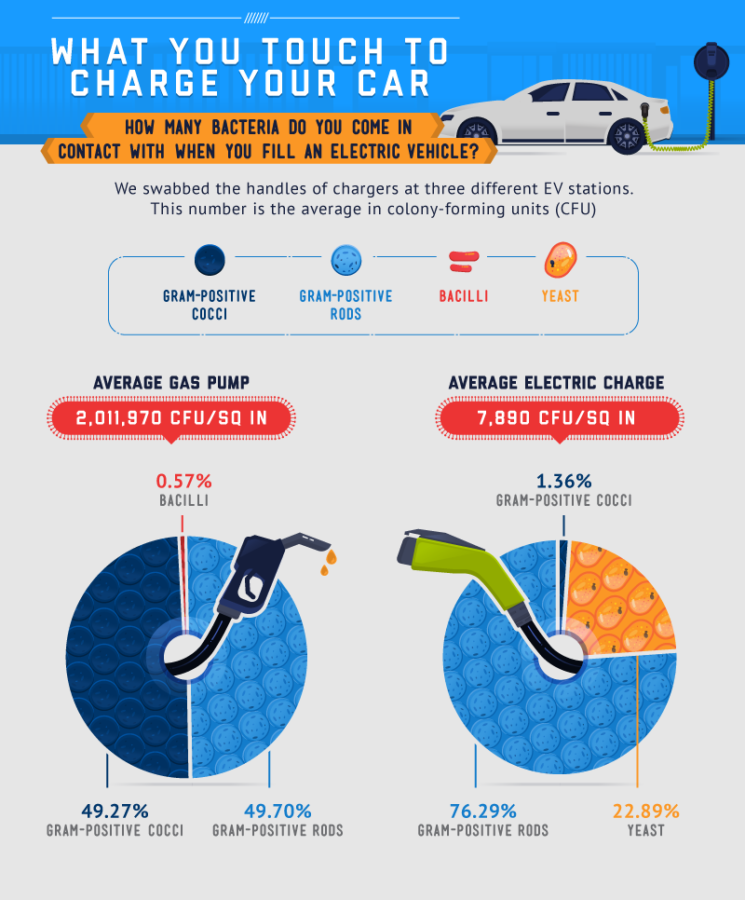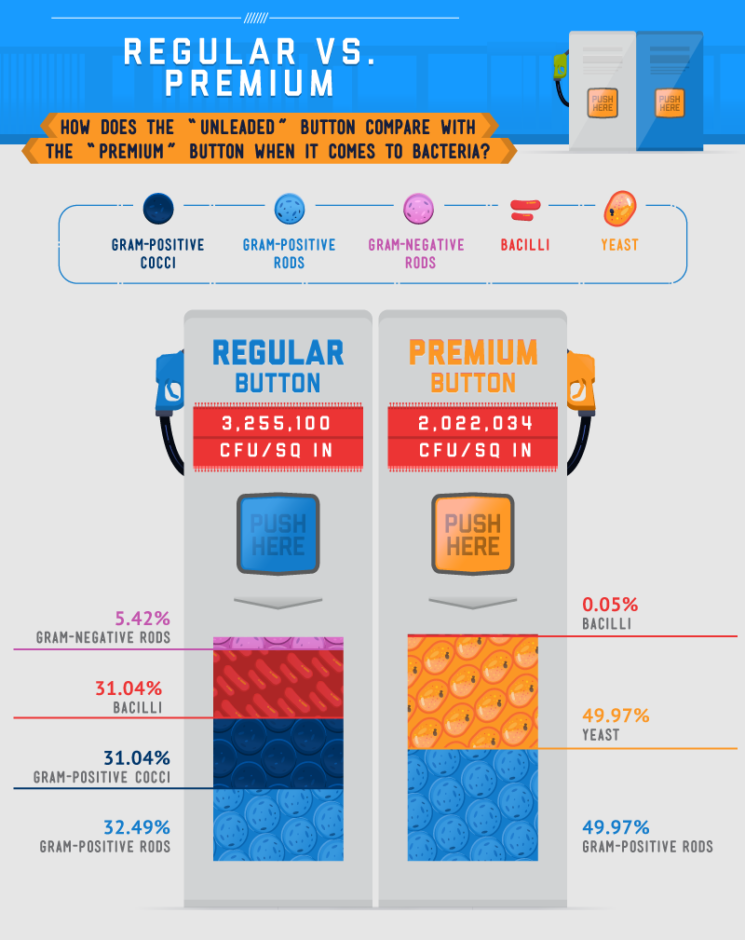Picture this: It’s a nice afternoon, and you’re driving toward a favorite destination. The windows are down, and the music is up. Things couldn’t get any better. Then, the gas light comes on – uh oh, you definitely don’t have enough fuel to get where you want to go. So you quickly turn into one of the many gas stations lining the street. You pull up to a pump, push some buttons, and – without a second thought – tightly grasp a handle and begin pumping. But while your mind innocently wanders, something more sinister is happening on your hand. Like the pumpers before you, you’ve just come in contact with millions of icky and nasty germs … and they’re not letting go.
It’s just a fact of life that if you have a car, you’ll have to visit a gas station sooner or later. That also goes for electric cars; unless you can charge your car at home, you’re probably a frequent visitor of public charging stations.
So how many germs live among gas and charging stations? More importantly, are they the truly vile kinds that can make you horribly sick? To find out, we collected bacteria samples from three gas stations and three charging stations. Keep reading to see which germs are lurking under the handles.
Pushing and Pumping Germs

Almost 40 million Americans fill up their gas tanks on a daily basis, yet most people don’t think twice before grabbing a handle or pushing a button to do so. But maybe you should. In fact, gas pumps tend to be the dirtiest things a person touches – 71 percent of gas pump handles are “highly contaminated” with microbes associated with illness and disease, according to a study by the Kimberly-Clark Corporation. And our test results, unfortunately, say the same thing.
When we looked at bacteria levels based on colony-forming units (CFU) – the number of viable bacteria cells – on items commonly thought of as dirty, gas pumps and buttons were the absolute filthiest. On average, gas pumps have more than 11,000 times more bacteria than the common household toilet seat. And pump station buttons fare even worse: roughly 15,000 times more bacteria! Even money, which can come in contact with thousands of unwashed hands, has only about 5.2 CFU/sq. in., while the seemingly dirty bottom of a purse has a mere 9.7 CFU/sq. in.
Pumped Germs vs. Charged Germs

As previously noted, the average gas pump has over 2 million CFU/sq. in. But which types of germs are breeding on them? As our study reveals, gas pumps are nearly equally crawling with gram-positive cocci (which can cause skin infections, toxic shock syndrome, and pneumonia) and gram-positive rods (which are usually harmless, but can sometimes cause different types of infections). There are even trace amounts of bacilli, which has been linked to food poisoning and infections in newborns.
And while you may assume that having an electric car will prevent you from coming into contact with these frightening germs, electric charging stations are also breeding grounds for gram-positive cocci and gram-positive rods. Even more, you could potentially be getting cozy with yeast (which can cause skin infections, especially in those with compromised immune systems). Whereas you’ll be exposed to millions of germs at gas stations, you’re only going to come into contact with about 7,890 CFU/sq. in. at an electric charging station. Maybe it’s worth spending a little extra dough on a Tesla, then.
The Battle of Regular Germs Against Premium Germs

You pull up to a pump, swipe your card, and wait for the prompts. The moment comes: Which gas are you going to get? If you’re like most Americans, you quickly press the regular gas button. Let’s be honest, premium gas is only a recommendation in some cars. Why spend more money when you don’t have to? But could saving those few extra cents per gallon put you directly in the line of fire when it comes to germs?
If you’re using the pumps we sampled, the answer is yes. According to our findings, the regular gas button has about 3,255,100 CFU/sq. in. On top of that, four different types of germs were detected: gram-positive rods (32.5 percent), gram-positive cocci (31 percent), bacilli (31 percent), and gram-negative rods (5.4 percent). Gram-negative rods, in particular, can be nasty – not only do they tend to be resistant to antibiotics, but they can cause deadly infections like meningitis and pneumonia.
If this makes you want to switch over to premium gas, you should probably know that germs are going to find you regardless of the pump you choose. In fact, the premium gas button has 2,022,034 CFU/sq. in., and is home to equal amounts of gram-positive rods and yeast (49.97 percent) and trace amounts of bacilli (.05 percent).
Fueled by Germs

Gas stations and charging stations are teeming with invisible pests. And because so many people need to fuel up at all times of the day, it’s almost impossible to clean pumps, buttons, and handles regularly. Even worse, germs on people’s hands can transfer seven times before leaving the skin. This makes for one seriously nasty situation.
When we looked at gas station germs by fuel type, the regular gas pump was bacteria-loaded. You only need to touch the regular gas button and the pump once to come into contact with about 5,267,070 CFU/sq. in. – that’s about 668 times more germs than if you were to grab an electric car charger (7,890 CFU/sq. in.). You would only be slightly better off if you were to pump premium gas – the process would bring you in contact with 4,034,004 CFU/sq. in.
The lesson learned? Germs are everywhere.
Travel With Style, Not With Germs
A lot of things are dirty, but gas stations might just take the cake. It’d be nice if our gas tanks were capable of self-filling, but until that happens, visiting a gas station is most definitely in your future. Luckily, there are things you can do to keep germs at bay, like using paper towels to grab and handle gas pumps, or washing your hands with antibacterial soap after visiting the pump. You could also get lucky and stop at a station with a U-Glove.
Now that you’ve read all about gas pump germs, forget about them! There may be a lot of germs out there in the world, but it’s still worth filling up your tank to visit friends or family. It’s time to embark on your next adventure!
And consider this: If you take a bus, you won’t even have to touch a gas pump. Busbud, with 500,000 bus routes across 63 countries and 10,000 cities, has partnered with hundreds of bus companies to provide affordable tickets to anywhere you want to go.
Sources:
http://www.nacsonline.com/YourBusiness/FuelsReports/2015/Documents/2015-NACS-Fuels-Report_full.pdf
http://info.debgroup.com/blog/bid/330913/What-is-the-Most-Contaminated-Object-in-Public-Washrooms
https://labtestsonline.org/understanding/analytes/gram-stain/tab/test/
http://www.diffen.com/difference/Gram-negative_Bacteria_vs_Gram-positive_Bacteria
http://www.ncbi.nlm.nih.gov/pmc/articles/PMC3647488/
http://www.encyclopedia.com/topic/Fungal_Infections.aspx
http://time.com/money/4349724/premium-gas-v-regular-gas/
https://www.cdc.gov/hai/organisms/gram-negative-bacteria.html
http://www.reuters.com/article/us-usa-health-filth-idUSTRE79O0G820111025
http://www.naturalnews.com/034046_gas_pump_bacteria.html
Methodology
Our testing was performed at EmLab P&K. Samples were collected from three different gas stations and three different charging stations. We swabbed pumps and buttons at the gas stations and handles at the charging stations. Our numbers are averages of all samples taken.
Fair Use
If you’re a writer interested in this project, we allow the use of the images above. When doing so, please attribute Busbud and provide a link so that readers can learn more if they want.